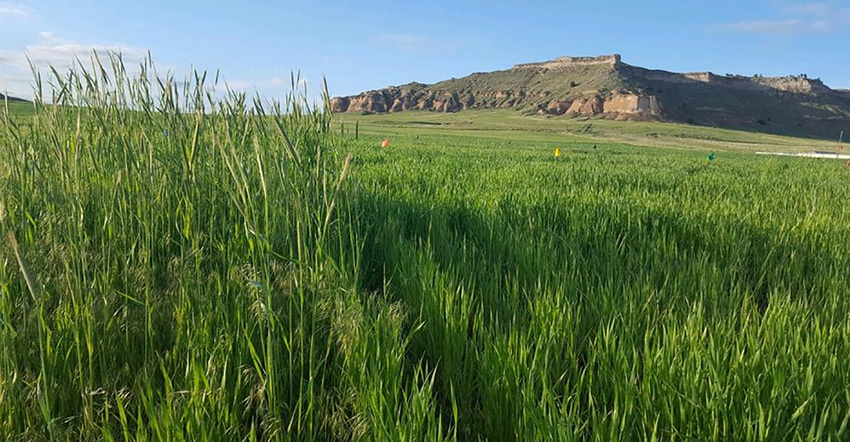September 10, 2018

By Cody Creech
A new herbicide-tolerant wheat production system is available to growers. The CoAXium Wheat Production System provides growers an additional option to control grassy annual weeds in wheat. The CoAXium system includes a new herbicide, Aggressor, and a patented trait that confers herbicide tolerance, AXigen.
Colorado wheat growers identified a need for a Clearfield alternative and pushed for a new system. The Colorado Wheat Research Foundation took the idea and provided funding to Colorado State University. CSU developed the trait and successfully incorporated it into many of its breeding lines. Other partners include Albaugh LLC and Limagrain Cereal Seeds.
Clearfield wheat was developed and released in 2001 by BASF. Initially, Clearfield wheat had only single-gene tolerance to Beyond (Imazamox), a Group 2 herbicide. Eventually, two-gene Clearfield wheat was developed and provided additional levels of crop safety and allowed the use of methylated seed oil, which increased the effectiveness of the herbicide.
The Clearfield Production System became the best method for growers to control problematic annual grassy weeds like downy brome, jointed goatgrass or feral rye. However, continued reliance on this system to control these problematic weeds has led to herbicide resistance in some areas. In addition, environmental conditions around the time of application must be ideal for Beyond to be effective.
Background info
Before using the system, understand these factors:
• All CoAXium wheat varieties will have two genes of tolerance and excellent crop safety. They can be identified by the AX suffix. Varieties available in 2018 include PlainsGold Incline AX and LCS Fusion AX.
• Growers must purchase new certified seed each year and adhere to a stewardship agreement. Saving seed to replant is not permitted.
• Aggressor herbicide is a Group 1 ACCase-inhibiting herbicide with the active ingredient quizalofop-p-ethyl. If applying a herbicide with quizalofop-p-ethyl to CoAXium wheat, only Aggressor brand herbicides registered for use can be used. New formulations of Aggressor are being developed to provide broadleaf control and will be available in the future.
• Aggressor herbicide only has grassy weed activity, and a broadleaf herbicide must be used to control broadleaf weeds.
• Adjuvants recommended include MSO, COC and NIS. Aggressor can be applied with nitrogen-based foliar fertilizers.
• Never tank-mix MCPA amine or 2,4-D amine formulations with Aggressor herbicide. This can be antagonistic and reduce the efficacy of Aggressor on grassy weeds.
• Beyond (Imazamox) will kill CoAXium wheat, Aggressor will kill Clearfield wheat, and both will kill non-traited wheat. Care should be taken to avoid misapplications.
• Application rates are 8 to 12 fluid ounces per single application, and 8 fluid ounces for a split application (fall-spring) not to exceed 16 fluid ounces in a season.
CoAXium wheat in 2018
The two commercial varieties that have been released for use in 2018 are PlainsGold Incline AX and LCS Fusion AX. Due to hail at some of the seed production fields, seed quantities are limited this year. If seed becomes available, a grower may consider seeding some in a small weedy area of a field to become familiar with the technology. It also could be seeded in a field that has grassy weeds that the Clearfield production system is no longer able to control.
Neither PlainsGold Incline AX nor LCS Fusion AX performed well in performance variety trials in 2018 and should not be used on a majority of a farm’s acres. Furthermore, they are not well adapted to Nebraska. These varieties will be short-lived and quickly replaced by better-yielding varieties in the coming years. Limagrain, CSU and UNL are all working on developing new varieties with the AXigen trait.
Nebraska research results
The Dryland Cropping Systems Program at the Panhandle Research and Extension Center has partnered with Albaugh LLC over the last three years to assist in developing use recommendations for Aggressor. Aggressor herbicide was evaluated at many rates, with different nozzles, carrier rates, adjuvants and timings. Here are a few key takeaways:
• No crop injury was observed with Aggressor when applied between the 4-leaf and stem elongation growth stages.
• It performed well under a variety of environmental conditions.
• Aggressor at a rate of 10 to 12 fluid ounces was needed for control of feral rye and jointed goatgrass.
• Aggressor at a rate of 8 fluid ounces was sufficient for downy brome control.
• If grassy weed pressure is high, use a fall application followed by a spring application
• Antagonism with tank-mix partners reduces efficacy. Only tank-mix with approved herbicides.
Stewardship guidelines
Stewardship of this new technology is critical to maximize efficacy and longevity of this production system. Growers must sign and adhere to a stewardship agreement. As part of this agreement, growers must purchase certified seed and follow the Aggressor herbicide label. Integrated best management practices include limiting the sole use of Aggressor herbicide to control grassy weeds.
Growers should rotate to other crops, use a fallow period, rotate herbicide modes of action, use proper timing of glyphosate in fallow year to limit weed seed production, or use Clearfield wheat to reduce selection of herbicide-resistant weeds caused by repeated use.
Creech is a Nebraska Extension dryland cropping systems specialist. This report comes from UNL CropWatch.
You May Also Like




